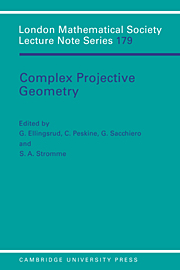Book contents
- Frontmatter
- Contents
- INTRODUCTION
- PROJECTIVE VARIETIES
- VECTOR BUNDLES AND SPECIAL PROJECTIVE EMBEDDINGS
- LIST OF PARTICIPANTS
- Speciality one rational surfaces in P4
- Bounding sections of bundles on curves
- The smooth surfaces of degree 9 in P4
- Compactifying the space of elliptic quartic curves
- Threefolds of degree 11 in P5
- Complete extensions and their map to moduli space
- On the Betti numbers of the moduli space of stable bundles of rank two on a curve
- Gaussian maps for certain families of canonical curves
- Geometry of the Horrocks bundle on P3
- Stability and restrictions of Picard bundles, with an application to the normal bundles of elliptic curves
- Sections planes et majoration du genre des courbes gauches
- A tribute to Corrado Segre
- Un aperçu des travaux mathématiques de G.H. Halphen (1844–1889)
- The source double-point cycle of a finite map of codimension one
- Fibré déterminant et courbes de saut sur les surfaces algébriques
- Courbes minimales dans les classes de biliaison
- Fano 3-folds
- Polarized K3 surfaces of genus 18 and 20
- Protective compactifications of complex afflne varieties
- On generalized Laudal's lemma
- Sur la stabilité des sous-variétés lagrangiennes des variétés symplectiques holomorphes
- Introduction to Gaussian maps on an algebraic curve
- Some examples of obstructed curves in P3
Compactifying the space of elliptic quartic curves
Published online by Cambridge University Press: 06 July 2010
- Frontmatter
- Contents
- INTRODUCTION
- PROJECTIVE VARIETIES
- VECTOR BUNDLES AND SPECIAL PROJECTIVE EMBEDDINGS
- LIST OF PARTICIPANTS
- Speciality one rational surfaces in P4
- Bounding sections of bundles on curves
- The smooth surfaces of degree 9 in P4
- Compactifying the space of elliptic quartic curves
- Threefolds of degree 11 in P5
- Complete extensions and their map to moduli space
- On the Betti numbers of the moduli space of stable bundles of rank two on a curve
- Gaussian maps for certain families of canonical curves
- Geometry of the Horrocks bundle on P3
- Stability and restrictions of Picard bundles, with an application to the normal bundles of elliptic curves
- Sections planes et majoration du genre des courbes gauches
- A tribute to Corrado Segre
- Un aperçu des travaux mathématiques de G.H. Halphen (1844–1889)
- The source double-point cycle of a finite map of codimension one
- Fibré déterminant et courbes de saut sur les surfaces algébriques
- Courbes minimales dans les classes de biliaison
- Fano 3-folds
- Polarized K3 surfaces of genus 18 and 20
- Protective compactifications of complex afflne varieties
- On generalized Laudal's lemma
- Sur la stabilité des sous-variétés lagrangiennes des variétés symplectiques holomorphes
- Introduction to Gaussian maps on an algebraic curve
- Some examples of obstructed curves in P3
Summary
INTRODUCTION.
An elliptic quartic curve (Γ¼ for short) is the complete intersection of a (unique) pencil of quadric surfaces. We obtain an explicit description of the irreducible component H of the Hilbert scheme parametrizing all specializations of Γ¼'s.
Global descriptions of complete families of curves in projective space are seldom found in the literature. The first non trivial case, concerning the family of twisted cubics in projective 3-space, was treated by R. Piene and M. Schlessinger [PS] (cf. also [EPS] and [V],[V']). Later, a partial compactification of this family was considered by S. Kleiman, A. Strømme and S. Xambó [KSX] in order to compute characteristic numbers, and in particular to verify the number, found by Schubert, of twisted cubics tangent to 12 quadric surfaces in general position.
There is a natural rational map from the grassmannian G of pencils of quadrics to H, assigning to a pencil π its base locus β(π). The map β is not denned along the subvariety B of G consisting of pencils with a fixed component.
Let G′ denote the blowup with center B. Let β′ : G′ … H be the induced rational map; it improves the situation in the sense that the image of β′ covers now all Cohen-Macaulay curves (e.g., planar cubic union a unisecant line).
A pleasant and surprising aspect of the geometry of G′ is the appearence of the locus of indeterminacy of β as the variety of flags of doublets in a plane, denoted C′.
- Type
- Chapter
- Information
- Complex Projective GeometrySelected Papers, pp. 47 - 58Publisher: Cambridge University PressPrint publication year: 1992
- 6
- Cited by



